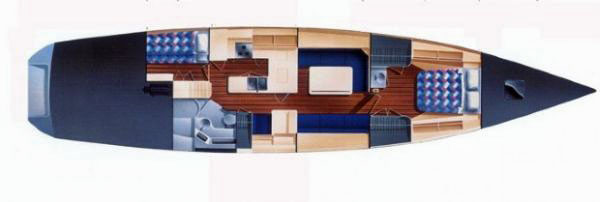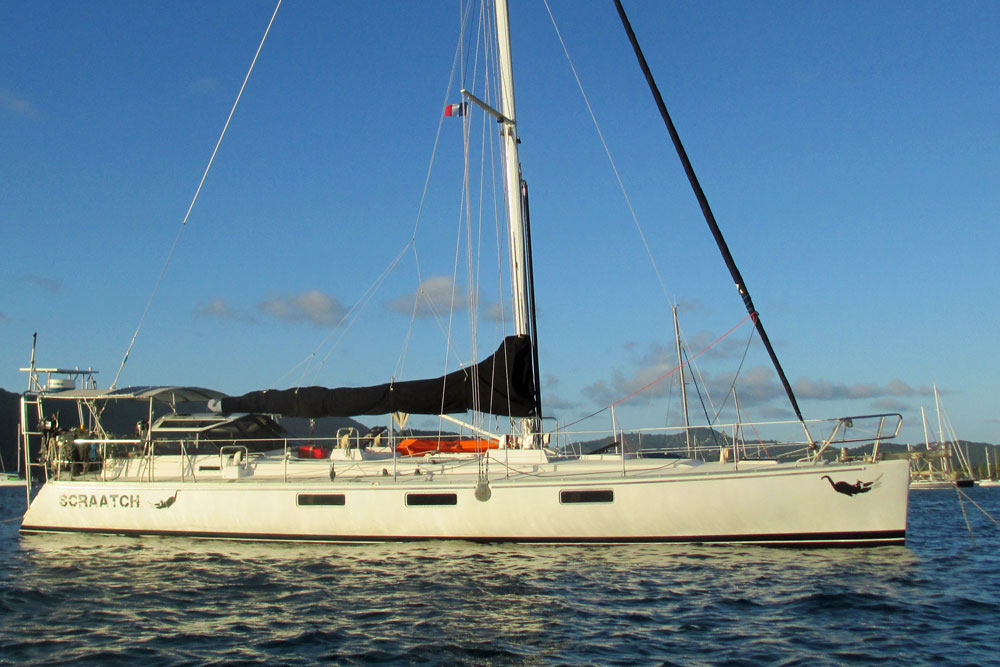- Home
- Cruiser Yachts over 55'
- Sundeer 56
The Sundeer 56 Sailboat
Specs & Key Performance Indicators
The Sundeer 56, an ultra-light fractional sloop, was designed by Steve Dashew and built in the USA by TPI Composites as a shortened version of the Sundeer 60.
Published Specification for the Sundeer 56
- Underwater Profile: Fin keel & spade rudder
- Hull Material: GRP (Fibreglass)
- Length Overall: 56'11" (17.4m)
- Waterline Length: 56'0" (17.1m)
- Beam: 13'9" (4.2m)
- Draft: 6'0" (1.8m)
- Rig Type: Fractional Sloop
- Displacement: 34,600lb (15,695kg)
- Designer: Steve Dashew
- Builder: TPI Composites (USA)
- Year First Built: 1994
- Year Last Built: 1997
- Number Built: 17
Published Design Ratios for the Sundeer 56
1. Sail Area/Displacement Ratio: 15.7
2. Ballast/Displacement Ratio: 28.9
3. Displacement/Length Ratio: 88.0
4. Comfort Ratio: 29.1
5. Capsize Screening Formula: 1.7
Summary Analysis of the Design Ratios for the Sundeer 56
1. A Sail Area/Displacement Ratio of almost 16.0 suggests that the Sundeer 56 will, in the right conditions, approach her maximum hull speed readily and satisfy the sailing performance expectations of most cruising sailors.
2. A Ballast/Displacement Ratio of 28.9 means that a sailboat like the Sundeer 56 (which doesn't have its ballast concentrated in a bulb at the foot of a deep keel), is likely to benefit from being reefed early to keep her sailing upright in a moderate breeze.
3. A Displacement/Length Ratio of just 88 places her firmly in the ultralight category.
4. Ted Brewer's Comfort Ratio of 29.1 suggests that crew comfort of a Sundeer 56 in a seaway is similar to what you would associate with the motion of a coastal cruiser with moderate stability, which is not encouraging news for anyone prone to seasickness.
5. The Capsize Screening Formula (CSF) of 1.7 tells us that a Sundeer 56 would be a safer choice of sailboat for an ocean passage than one with a CSF of more than 2.0.
More about the Sundeer 56 Sailboat...
The Sundeer 56 is a shortened version of the Sundeer 60, which was conceived as the most efficient two-person cruising boat by the Dashews, who are renowned for their expertise in offshore sailing and yacht design. Only 17 units of the Sundeer 56/60 were built between 1994 and 1997, making them rare and sought-after by adventurous sailors who value performance, safety and simplicity.
 The long and narrow accommodation of the ultra-light displacement Sundeer 56
The long and narrow accommodation of the ultra-light displacement Sundeer 56The Sundeer 56 has a distinctive look that reflects its no-nonsense offshore philosophy. It has a plumb bow with a tough bowsprit for anchor clearance, a straight and slightly uplifting sheer, a wide beam that stays aft, a cut-off stern with a molded swim platform, and three large and squarish portlights on each side of the hull. The hull shape is narrow (with a length-to-beam ratio of 4.9) and has very fine entries (14 degrees from centerline) to cut through waves upwind and surf downwind. The Sundeer 56 can easily average over 200 nautical miles a day offshore, thanks to its long waterline length (17.1 meters) and large sail area (96.9 square meters).
The rig is a simple sloop with a raked, double-spreader mast. The mainsail is large and powerful, while the foresail area is flexible and can accommodate different combinations of jibs, staysails, genoas and spinnakers. The mast height can vary depending on the owner's preference, but it is usually around 19.7 meters above the waterline. Some Sundeer 56s have swept-back spreaders or a B&R rig to reduce the need for running backstays.
The keel is a fin keel with a lead bulb that provides stability and reduces draft to 1.8 meters. The rudder is a spade rudder with a long and skinny skeg that protects it from damage and improves tracking. The propeller comes out close to the skeg on a steep angle to reduce drag and cavitation.
The cockpit is located aft and can be either center or wheelhouse style. It has a single or twin wheel steering system that can be connected to a tiller for emergency use. The cockpit is spacious and well-protected by a dodger or hard top, with good visibility and access to the sail controls. The cockpit also has ample storage space in lockers and lazarettes.
Accommodation
The interior of the Sundeer 56 is designed to be comfortable, practical and durable for long-term cruising. It has a deck saloon layout that offers plenty of natural light and ventilation through large windows, hatches and dorades. The headroom is generous throughout, ranging from 1.9 to 2 meters.
The saloon is located forward of the mast and features a U-shaped dinette to port that can seat six people comfortably around a large table that can be lowered to form an extra berth. To starboard, there is a long settee that can also serve as a sea berth, with storage space underneath and behind.
- The galley is located aft of the saloon to port, in an L-shaped configuration that provides ample counter space, storage space and access to the cockpit. The galley is equipped with a three-burner stove with oven, a double sink with hot and cold water, a top-loading refrigerator and freezer, and a microwave oven.
- The navigation station is located aft of the saloon to starboard, opposite the galley. It has a large chart table with drawers and shelves, an adjustable seat, and an array of instruments and electronics;
- The owner's cabin is located forward of the saloon. It has a large double berth, a hanging locker, drawers, shelves, and a private access to the forward head with shower. The forward head can also be accessed from the saloon.
- The guest cabin is located aft of the galley, in the port quarter of the boat. It has two single berths that can be converted into a double berth with an insert cushion, a hanging locker, drawers, shelves, and an ensuite head with shower.
The Sundeer 56 has a warm and cozy atmosphere inside, with teak woodwork, white bulkheads, blue upholstery and brass fittings. The cabin sole is made of teak and holly, and the overhead is lined with vinyl. The lighting is provided by LED lamps and reading lights. The ventilation is ensured by 12 opening ports, 8 deck hatches and 4 dorade vents.
Hull and Deck
The hull and deck of the Sundeer 56 are made of fiberglass with balsa core for stiffness and insulation. The hull is molded in one piece with an integral grid structure that supports the keel, mast and rigging loads. The deck is bonded to the hull with epoxy and through-bolted on an inward flange. The hull-to-deck joint is covered by a teak toe rail that adds strength and beauty.
The deck is wide and flat, with molded nonskid surface for traction and safety. The deck hardware is of high quality and well laid out for easy handling of the sails.
Accolades & Awards
- The Sundeer 56 was named one of the "Best Boats of 1995" by Sail Magazine;
- The Sundeer 56 was awarded the "Best Offshore Cruiser" by Cruising World Magazine in 1995;
- The Sundeer 56 was featured in the book "The World's Best Sailboats: Volume II" by Ferenc Mate in 1996;
- The Sundeer 56 was praised by the renowned sailor and author Jimmy Cornell in his book "World Cruising Routes" as a "superbly designed and built boat that can take you anywhere in the world in comfort and safety".
This article was written with the assistance of Gemini, a large language model developed by Google. Gemini was used to gather information, summarize research findings, and provide suggestions for the content and structure of the article.
Recent Articles
-
Hans Christian 43: Classic Bluewater Cruiser & Liveaboard Sailboat
Dec 10, 25 04:37 AM
Explore the Hans Christian 43: a legendary heavy-displacement, long-keel sailboat. Read our in-depth review of its specs, design ratios, and suitability for offshore cruising and living aboard. -
Planning Your Sailboat Liveaboard Lifestyle: An Ocean Sailor's Guide
Dec 06, 25 05:18 AM
Seasoned sailors share their methodical risk analysis for planning a secure Sailboat Liveaboard Lifestyle, covering financial, property, and relationship risks. -
Marine Cabin Heaters: The Expert’s Guide to Comfort & Safety at Sea
Dec 05, 25 06:52 AM
Choose the best Marine Cabin Heaters for your vessel. Expert advice on diesel, paraffin, and hot water systems for year-round cruising comfort.














